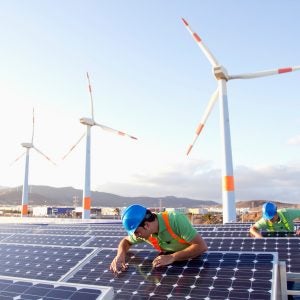The energy job market is in trouble. Here’s how we fix it.
 The coronavirus is inflicting a heavy toll on America: Over 100,000 dead, almost two million infected, and more than 40 million unemployed. Beating the virus is the top priority. But we also need to put people back to work as fast as safety allows. How we go about that now will determine our nation’s economic future for decades.
The coronavirus is inflicting a heavy toll on America: Over 100,000 dead, almost two million infected, and more than 40 million unemployed. Beating the virus is the top priority. But we also need to put people back to work as fast as safety allows. How we go about that now will determine our nation’s economic future for decades.
To achieve lasting prosperity, we need to rebuild better by investing in jobs that restart the economy, improve the environment and move us to a cleaner future.
Energy jobs in free fall
Before the pandemic, clean energy was one of the U.S. economy’s fastest-growing job creators — up more than 10% between 2015 and 2019, employing nearly 3.5 million people (three times the number working in fossil fuels). The Bureau of Labor Statistics predicted last year that solar panel installers and wind turbine technicians would be two of the fastest growing occupations of the next decade.
The energy job market is in trouble. Here's how we fix it. Share on XBut then clean energy lost at least 600,000 jobs in March and April alone, according to BW Research. More than 95,000 workers in the renewables industry found themselves on the street. But the largest share came from energy efficiency — the building trades that install new lighting or heating, ventilation and air conditioning systems in homes and offices.
While California lost the most, Florida, Georgia, Texas and Michigan each shed over 22,000 clean energy jobs in April alone. This comes on top of news from the oil patch, where tens of thousands of workers have been furloughed or laid off due to the historic drop in global oil and gas demand.
Clean energy as key to economic recovery
It is hard to imagine rebuilding our economy without a strategy for getting America’s energy workers back to work. There is not a moment to lose for those folks facing next month’s mortgage payment.
So what can we do right now?
For starters, Congress could bring back direct payments and expanded tax credits to renewable energy developers, and expand existing incentive programs already in place. Lawmakers could also revive successful programs to fund energy efficiency investment in homes, schools and municipal buildings nationwide — precisely the workforce hit hardest in the pandemic. They could also pass a bill to step up construction of electric vehicle infrastructure.
E2, a nonpartisan group of over 8,000 business leaders, investors and other professionals, assembled a much more detailed list in a recent letter to Congress.
We know how effective these policies are. In fact, the pre-virus clean jobs boom was due at least partly to the stimulus bill passed after the 2008 financial crisis, which provided the biggest investment in clean energy in U.S. history. That package funded 100,000 projects, provided loans to help companies like Tesla build new factories and tripled our wind and solar capacity.
Oil & gas workforce, today and tomorrow
There are plenty of valuable skillsets across the oil and gas industry that could also do a lot of good for the environment. Putting oil patch workers back in the field to plug and remediate the tens of thousands of old, orphan wells could stop untold amounts of methane and other pollution from leaking into the air and water indefinitely.
There’s also an urgent need to fix leaks and cut emissions at active oil and gas facilities still operating. The Canadian government included support for such measures in its energy stimulus plan. Ironically, U.S. oil and gas companies have been pressing to roll back rules that already require some of this.
In the face of a contracting industry, oil and gas workers will confront a changing energy job market, marked by increasingly stiff competition from zero-emission energy sources and the wave of automation and consolidation that has followed every down cycle in the history of their boom-and-bust industry.
That’s why a smart and equitable national energy strategy would be structured to put people back to work immediately, taking full advantage of the skills they currently have, even as we invest in the technologies and skills necessary for a cleaner and more sustainable future.
Over the longer term, the skills of many traditional oil and gas workers will be in demand constructing and maintaining offshore wind turbines, engineering and operating industrial carbon capture and storage projects, or producing and distributing the ‘green’ hydrogen that could one day play a role in meeting the energy needs for transportation, industry and buildings.
It’s time to rebuild better
Shocks to the system, from the global pandemic and civil unrest to devastating weather events made worse by climate change, have all underscored the importance of decisive policy action.
Restarting the American economy and pointing ourselves in the direction of sustained growth requires us to embrace and accelerate the many changes that were already underway to transition the global energy system toward a net-zero economy by 2050.
There are plenty of good clean energy-related jobs at the ready for oil and gas and clean energy workers together, if federal policymakers embrace a clean energy future and take the actions necessary to achieve it. American energy workers are counting on them to do their part and get the job done right.











